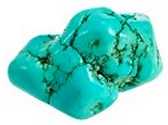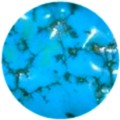|
The Feel-Good Guide to Sports, Travel, Shopping & Entertainment
|
||
| Main | Sports Events | Holidays & Observances | Pop Culture | Shopping | Travel |
|
MAIN
The Beauty and History of Turquoise: Turquoise history dates back over 6000 years. Archaeological and literary references to the gemstone predate the Christian era by five millennia. It has been unearthed in tombs from ancient Egypt...specifically the 4 bracelets of Queen Zar, found on her mummified arm. These date back to the second ruler of Egypt's First Dynasty, approximately 5500 BC! Aristotle and Pliny both refer to turquoise. Marco Polo even wrote about it. Turquoise has always been considered a stone of life. It also has a long standing history of more than 1000 years with Native Americans who have used it extensively for protection and healing. The stone was also used in religion, art, trade, treaty negotiations and, of course, treasured jewelry. Turquoise - the healing stone Turquoise's use as a healing stone reaches far into history. It has been used for headaches, eye problems, fever and insect bites to name just a few. It was ground to a powder then swallowed to cure stomach ailments. Turquoise also has significant metaphysical properties. It is a harmonizing stone that is said to alleviate nervousness, help with problem solving, relieve stress from a hectic life, and promote friendship. It is also well known for its protective qualities and people from many different cultures have been known to carry turquoise stones with them at all times. Shopping for turquoise jewelry
Turquoise can be rather porous and chalky and is often not suitable for jewelry until it is treated. There are various processes that are used on turquoise. Stabilization is one treatment which is used on turquoise. In this process a resinous substance is bonded to the raw gemstone. Pressure and heat are applied and the microscopic gaps in the stone fill with the plastic resin. When cured the product is a treated stone hard enough to cut and polish. Stabilization allows genuine but lower grade turquoise to be used in jewelry. Stabilization helps to keep the stone from chipping and prevents changes in color from contact with skin oils. Wax treatment is also very common with turquoise. This process is often used with turquoise from China. Paraffin wax is impregnated into the turquoise to deepen and stabilizes the color but it only affects the surface.
Another process is referred to as 'block' turquoise. To make this type of turquoise, plastic resin and dyes are mixed and then shaped into blocks of turquoise about the size of a loaf of bread. There are no actual turquoise gem stones in this mix, it is entirely man made and should be labeled simulated. It is made in many colors and produces a very attractive and durable stone. Block turquoise is used extensively for inlay work. So, when in the market for turquoise jewelry be aware of what you are purchasing. Simulated turquoise and a natural piece of turquoise jewelry are both terrific. Whatever your needs are, just be certain the product you are purchasing is priced according to its composition. Enjoy this truly captivating stone!!
More about turquoise around the Web: The Do's and Don't's of Shopping for Turquoise
|
 The
beauty and history of turquoise is hard to surpass! Seeped with
history and mystery it is truly a captivating stone.
The
beauty and history of turquoise is hard to surpass! Seeped with
history and mystery it is truly a captivating stone.  Turquoise
is often strung on beads, carved into animal fetishes, or combined
with other stones such as onyx, amethyst, or coral. Its color
ranges from brilliant sky blue to green and it usually has black
or brown veins running through it. In jewelry it is very popular
set in sterling silver. Silver enhances the natural colors of
the turquoise much better than gold. Turquoise is found in North
American, especially in the dry areas of Arizona and New Mexico.
It is also found in China, Iran, Turkey, Egypt, and Persia.
Turquoise
is often strung on beads, carved into animal fetishes, or combined
with other stones such as onyx, amethyst, or coral. Its color
ranges from brilliant sky blue to green and it usually has black
or brown veins running through it. In jewelry it is very popular
set in sterling silver. Silver enhances the natural colors of
the turquoise much better than gold. Turquoise is found in North
American, especially in the dry areas of Arizona and New Mexico.
It is also found in China, Iran, Turkey, Egypt, and Persia.  Some jewelry
may be made with
Some jewelry
may be made with 